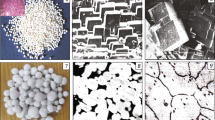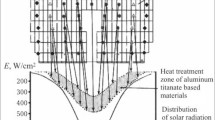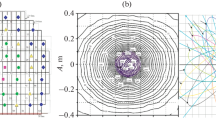The problem of energy shortage governs the search for renewable energy sources. Solar energy is used to synthesize and study the properties of the following oxide compounds: REE titanates (La–Lu), titanates of the pseudo-brookite type, solid solutions of the fluorite type based on ZrO2 and HfO2, and superconductors of theseries Bi1.7Pb0.3Sr2Ca n–1Cu n O y (n = 2 – 20). The advantages of synthesis technology using solar energy and a favorable change in ceramic functional material properties is demonstrated.

Similar content being viewed by others
References
G. V. Samsonov, A. A. Borisova, and T. G. Zhidkova, Physicochemical Properties of Oxides: Handbook [in Russian], Metallurgiya, Moscow (1978).
P. B. Budnikov and D. Poluboyarinova, Chemical Technology of Ceramics and Refractories [in Russian], Stroizdat, Moscow (1972).
Yoshihiro Abe (editor), Superconducting Glass-Ceramics in Bi–Sr–Ca–Cu–O. Fabrication and its Application, Nagoya Institute of Technology, Japan (1997).
V. A. Baum (editor), Solar High-Temperature Furnaces: Collection [in Russian], IL, Moscow 1960).
M. Foex, “Investigations of structures transformations of refractories above 2000 °C,” Trans. Brit. Ceram. Soc., 67(11), 462 (1968).
D. D. Gulamova, T. T. Riskiev, and M. Kh. Sarkisova, USSR Inventor’s Cert 275678, Claim 02.13.87.
A. Ya. Sushchenko, D. D. Gulamova, and S. N. Novoselova, “Contact phenomena in cases of ionic conductivity and quasichemical reaction of crystal lattice defects (phenomenological theory),” Izv. Akad. Nauk SSSR, Neorgan. Materialy, 29(1), 282 – 284 (1993).
S. A. Azimov, T. T. Riskiev, and D. D. Gulamova, Prospects for Using Solar Furnaces in Technology for Producing Highly Refractory Materials [in Russian], Tez. Nauch. Tekhn. Conf., Bogdanovichi (1984).
V. B. Glushkova, É. K. Keler, L. G. Shcherbakova, and E. Ya. Shcherbakovskii, “Study of stability of solid solutions in ZrO2–Ln2O3 systems,” Izv. Akad. Nauk SSSR, Neorgan. Materialy, 7, No. 11, 2007 – 2014 (1971).
T. A. Volkova, V. L. Grachev, and D. D. Gulamova, USSR Inventor’s Cert. 261787.
D. D. Gulamova and M. Kh. Sarkisova, “Effect of microstructure features on aluminum titanate stability,” Novye Ogneupory, No. 5, 2 – 4 (1991).
D. D. Gulamova and S. N. Novoselova, “Effect of synthesis by melting in solar and radiation furnaces on change in phase composition in systems ZrO2–CaO(MgO)–Gd2O3,” Zh. Neorg. Khim., 36(11), 2944 – 2948 (1991).
K. Tyson, J. Kniec, J. V. Acrivos, J. G. Chigvinadze, and D. D. Gulamova, “Bond resonance in sun powered synthesized, fast cooled layer superconducting alloys (SFAQ technology) (Bi1.7Pb0.3Sr2Ca n–1CunO2n + 4 + d )2, n = 1 – 9,” 243rd AÑS National Meeting & Exposition, March 25 – 29 2012, San Diego, CA.
Author information
Authors and Affiliations
Corresponding author
Additional information
Translated from Novye Ogneupory, No. 3, pp. 123 – 126, March, 2014.
Rights and permissions
About this article
Cite this article
Gulamova, D.D., Shevchenko, V.P. Synthesis of Ceramic Materials Using Energy-Saving Ecologically Clean Solar Energy. Refract Ind Ceram 55, 111–113 (2014). https://doi.org/10.1007/s11148-014-9670-7
Received:
Published:
Issue Date:
DOI: https://doi.org/10.1007/s11148-014-9670-7




